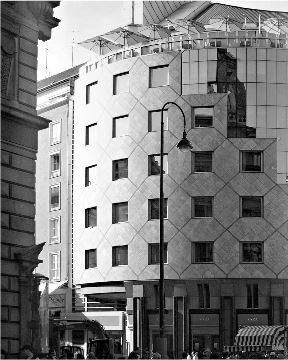Submitted by WA Contents
December 1988: Complexes Of Hans Hollein
United Kingdom Architecture News - May 13, 2014 - 13:41 3499 views
Hans Hollein’s career started in Vienna with very small projects and a series of artworks and exhibition designs which focused world attention. In this Archive piece from 1988, Peter Davey looks at Hollein’s first two sizeable buildings in his native city.

Read Publication on ISSUU
Hans Hollein is, in some ways, typical of his generation of Austrian architects. Born in 1934, and trained in Austria, he studied and worked abroad, in the US, Sweden and Germany, before setting up in practice in 1964. As with several of his contemporaries, the foreign experience gave him an ability to see back into Austrian history beyond the year zero (1945) and to tap into tradition without embarrassment or chauvinism. Like his fellow Viennese (p25), Hollein began with very small, highly-charged works: a series of small shops and interiors. One of the major levers which projected Hollein into world architectural prominence was being made recipient of the Reynolds Architectural Award for the tiny Retti Candle shop in 1966.
Since then, he has become part of the global circuit, frequently answering to analyses of his work by replying that ‘I am an international architect, not an Austrian one’. Yet he remains very much part of Austrian architectural culture: he bridges the gaps between fine art, design and architecture, just as did his predecessors at the turn of the twentieth century and theirs before them back into the Baroque. And he retains a Viennese sensibility.
Many years of designing brilliant exhibitions (the most recent of which was the amazing Traum und Wirklichkeit-a dramatic exposition of the intellectual and physical history of Vienna, AR November 1985) have given Hollein a strong sense of theatrical effect, and a talent for intensifying sense of place for particular purpose.
Hollein, while he quotes liberally and frequently from the past, is by no means a Post-Modern Classicist, though he has sometimes been claimed to be of that camp. He is far too original and witty for any such description-and far too steeped in the history of Vienna to make a facile, facadist architecture. Yet his new work resonates with the city.
Hollein’s exhibitions and his earlier buildings show an affection for the standard Viennese fin-de-siecle preoccupations: death, sex and refined ostentation. Of the two Hollein projects shown here, the school exhibits a loving understanding of children’s physical and psychic needs and-extends his range. So we start with it...Continue Reading
> via The Architectural Review
